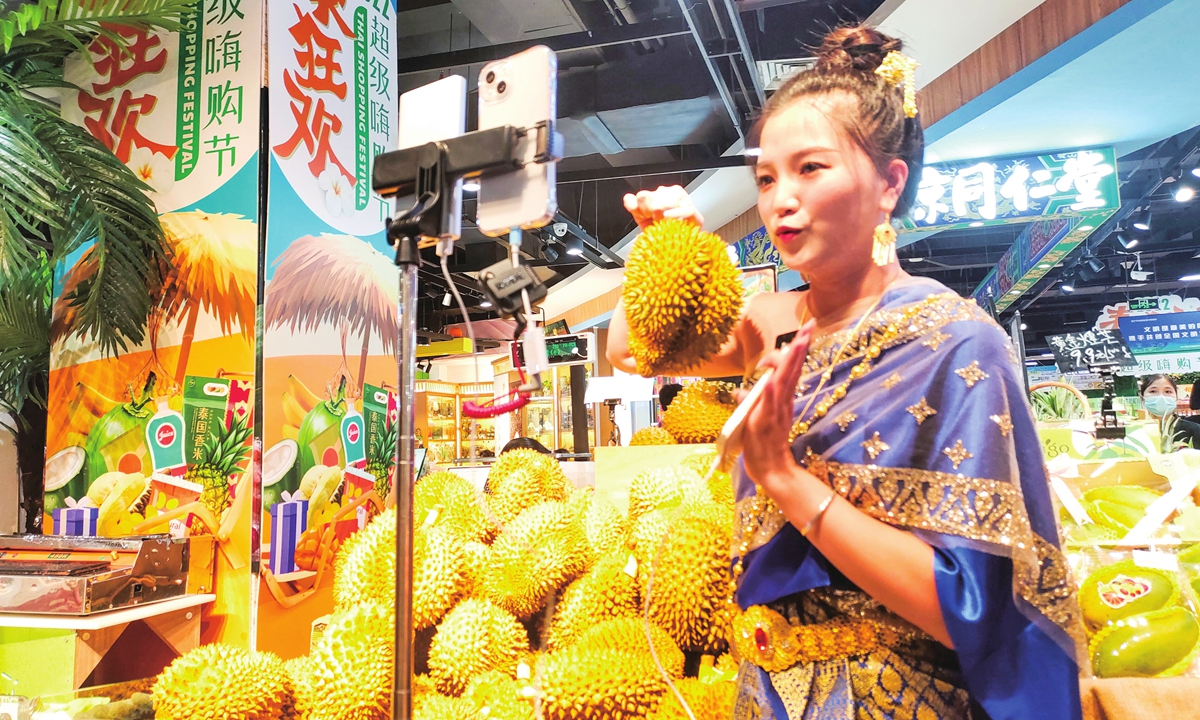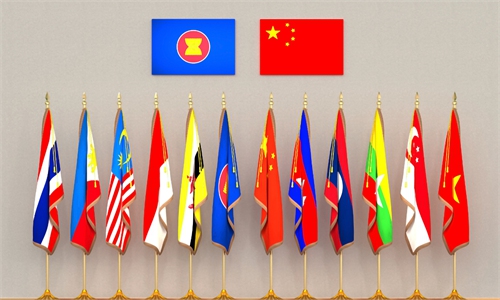Trade between China and ASEAN grows 15% in 2022, first year of RCEP’s enforcement
First year of RCEP enforcement brings regional industrial chain closer

Sales staff shows durian imported from Thailand. Photo: VCG
China has witnessed a year-on-year trade increase of 15 percent with the Association of Southeast Asian Nations (ASEAN) in 2022, the first year the Regional Comprehensive Economic Partnership (RCEP) went into effect, and the region continues to hold the position of China's top trade partner.
Chinese experts said that the effective implementation of RCEP has been an important driving force behind the stable growth, and further growth in trade is expected, supported by the giant potential.
China's imports and exports to ASEAN came to 6.52 trillion yuan ($970 billion) in 2022, a significant increase of 15 percent. Of this, exports made up 3.79 trillion yuan, an increase of 21.7 percent, and imports made up 2.73 trillion yuan, up 6.8 percent, data from the General Administration of Customs (GAC) showed on Friday.
Lü Daliang, spokesperson of the GAC, attributed the growth to the effect brought by the RCEP, which has pushed the industrial chain closer.
The very beginning of 2023 marks the first anniversary of the entry into force of the RCEP. With one year on, the RCEP agreement has shown great vitality, effectively boosting trade among member countries and benefiting the regional economy.
Over the past year, the agreement has lowered the cost of trade and facilitated the integration of industrial chains, and Chinese experts said its enforcement has helped the recovery of the Asia-Pacific economy, offsetting headwinds from sluggish global demand and other factors.
ASEAN is an important trading partner of China in RCEP. In 2022, China's trade with ASEAN accounted for 50.3 percent of the scale of imports and exports to other RCEP member countries, customs data showed, of which China's trade in intermediate products to ASEAN came to 4.36 trillion yuan, a year-on-year increase of 16.2 percent, accounting for 67 percent of the total trade value between China and ASEAN.
Lü said the continuous advancement of facility interconnection has made trade exchanges easier, which also drives trade growth with ASEAN.
In 2022, China's imports and exports to ASEAN by railway, waterway and air increased by 197.6 percent, 26.7 percent and 15.5 percent respectively. In particular, the opening of the China-Laos Railway to traffic at the end of 2021 has provided new impetus for further cooperation between China and related countries.
In 2022, among the goods transported by China between ASEAN by railway, the proportion of goods transported by the China-Laos railway jumped to 44.7 percent, and the contribution made to the growth of imports and exports by railway between China and ASEAN exceeded 60 percent, customs data showed.
Lü added that the deepening of cooperation in agricultural products also promotes the expansion of imports.
China has accelerated the pace of imports of agricultural products from ASEAN members and continued to optimize quarantine access procedures for key agricultural products. Various agricultural products including fresh durian from Vietnam, fresh longan from Cambodia, and passion fruit from Laos have gained new quarantine access in China.
In 2022, China imported 246.86 billion yuan of agricultural products from ASEAN, a year-on-year increase of 21.3 percent, accounting for 15.7 percent of China's import and export value of agricultural products during the same period, an increase of 1.4 percentage points over the previous year.
China said it will allow imports of durian from the Philippines after the product meets certain requirements, read a statement on the official WeChat account of GAC on Monday.
Building a more robust bilateral relationship between China and ASEAN members will help further enhance the level of multilateral cooperation between the two sides, Xu Ningning, executive president of the China-ASEAN Business Council, told the Global Times in an earlier interview.
Chinese companies are busy grabbing the opportunities provided by ASEAN. On January 5, South China's Guangxi Zhuang Autonomous Region sent out its first business delegation in nearly three years since the outbreak of the COVID-19 epidemic. The delegation will visit a number of ASEAN members including Cambodia, Malaysia and Singapore.
Driven by the continuous improvement in bilateral trade and investment liberalization and facilitation, the bilateral trade between China and ASEAN is expected to achieve new and greater development, Lü said.



